Abstract
Implementation of innovative development model adopted in Russia due to the influence of territorial differentiation and heterogeneity of economic space gives mixed results in the regions. This is accompanied by the problems, ultimately associated with improving the quality of life of the population. The quality of life is the resulting indicator reflecting the level of territory development and its living conditions. At present, there is no clear understanding of which exactly factors make the main contribution to the establishment of a particular living standard. It is clear that the presence in the territory of advanced industries using innovative technologies should have a positive effect on the dynamics of economic factors that contribute to the indicator value of quality of life. This means that we need approaches that allow us to connect the factors of innovative development of the regions and the quality of life of the population in them. The authors analyze the relationship between the indicators “innovative development – quality of life” using the methods of correlation and regression analysis; evaluate the feasibility of using indicators related to advanced technologies use for the analysis of regions’ innovative development. They also propose an approach that can become an effective tool, both when choosing strategic guidelines and methods of current management.
Keywords: Innovative developmentquality of lifeadvanced manufacturing technologiesquality economics
Introduction
The formation of theoretical and methodological approaches to solving problems of raising the level and quality of life, satisfaction with conditions of human life, and with them social welfare, form the cornerstone of the concept of quality economics since its inception. The rapid digitalization of modern economics, largely due to introduction and using of innovations in all key areas, has become the most explicit indicator of innovative development.
The choice of innovative development model in Russian economy is driven by the need to improve the level and quality of life of population in the regions, to develop new approaches to solving environmental, economic, socio-demographic and other current problems. Innovative development is the result of specific creative activity of thousands of people and in itself does not automatically provide high quality of life for each society member. However, participation in such development increases social motivation creating opportunities for self-realization, creativity and sets new benchmarks for quality of life.
In the interest of accelerating economic growth and development pace, searching for opportunities of taking into account the regions’ innovative development factors in assessing the population quality of life becomes especially relevant.
Problem Statement
The problems of improving the population quality of life have not lost their relevance over the past decades. This is one of the reasons why many approaches to the quality of life study were born and exist including the most well-known ones: philosophical, psychological, economic and environmental approaches.
Against the background of a multiplicity of approaches to the quality of life study, methodological support for measuring quality of life is no less extensive. The most popular domestic methods are considered to be those of the Ministry of Economic Development S.A. Ayvazyan (CEMI) and others. The methodology of the United Nations Development Program (UNDP), aimed at supporting sustainable development in all countries, is also widely used in assessments’ formation of quality of life.
The methods differ both in the use of a variety of tools and in the careful selection of characteristics and assessment indicators.
For decades, the ideas of quality economics have been used in international comparisons not only to evaluate, but also to improve living conditions and quality of life in countries with different levels of economic development. As the concept of quality economics developed, there was made a transition from product quality to process quality, and further: to quality of activities organization and, finally, to the resulting indicator – quality of life. This study develops a process approach to understanding the conditions for the quality of life formation in a regional context.
Research Questions
In the framework of the quality economics concept, the following quality of life concept is used. The quality of life is an assessment category that in a generalized sense describes the parameters of all components of human life: their potential, life activity and living conditions, in relation to the standard developed and institutionalized by the society and (or) existing in the individual human mind (Okrepilov & Gagulina, 2019).
A considerable theoretical and methodological basis for assessing the quality of life of the region’s population on a conceptual basis of quality economics has been formed at the Institute of Regional Economics Problems of the Russian Academy of Sciences. The complexity and versatility of the category “quality of life” became a decisive argument in favor of using the theory of random functions in order to consider some averaged properties of the statistical aggregate of the quality of life processes implementation that correspond to a set of fixed external conditions. The quality of life is a very broad multidimensional indicator, which is based on a complex of heterogeneous components. When modeling the quality of life of the region’s population, it was decided to rely on the methodology of a comprehensive quantitative measurement of quality, the basis of which make up the following initial points:
Quality is considered as a certain hierarchical set of living conditions significant for the population, business, public organizations and the state;
The quality of life as a certain generalized complex property of population life occupies the highest level of the hierarchical system of properties.
The state (value) of quality of life field, formed by a random function of several arguments, is described as a hierarchical set of functional dependencies in which indicators of groups of related quality of life characteristics: quality of health, quality of living environment, quality of providing biological needs, quality of providing social needs, environmental quality and quality of institutions, form the basis for the formation of integral indicators of quality of life. Basically, they contain more private indicators of the next level that characterize certain aspects of quality of life. For example, the quality of health is characterized by medical and demographic indicators, indicators of the quality of medical care. The quality of the environment is characterized by climatic conditions and living conditions of people. The quality of providing biological needs is determined by their diversity and characterized by the standard of living, the quality of training and education, the development level of infrastructure and housing services.
Purpose of the Study
The approach to theoretical and methodological justification of level and quality of life in the context of an innovative economics involves clarification of the factors that affect the level of quality indicators (Shilov, 2011). In this regard, it is necessary to carry out:
coverage indicators of vectors that determine the quality of life vector, including medical and demographic conditions, socio-economic well-being, comfort and safety of living environment of the region's population;
rating the quality of life of the region’s population on the official statistics basis;
introduction of the results into the management system through a multi-level quality management system with possible inclusion of innovative components in the dynamics of the population quality of life.
Research Methods
As innovative achievements spread, there is not only spatial, but also temporal improvement of quality of life. Quality of life processes form an appropriate environment for human well-being, which is especially pronounced in the era of accumulation and extensive use of information (Houneida & Slim, 2018). The quality economics has necessary conceptual and theoretical-methodological base suitable for solving the problems of region’s quality of life improving. The study aimed at finding ways to solve regional problems of quality of life can be based on the following panel formula:
where
Of particular interest is the introduction of variable indicators that make it possible to take into account the results of quality of life management in the framework of a multi-level quality management system for innovative development of the region's economy.
Findings
The influence of the innovative development level on the state of the overall economy and, ultimately, on the quality of life, is especially evident if innovation is commercialized. In order to take into account the contribution of the innovative component in assessing the quality of life, we will use the indicators “developed advanced manufacturing technologies” and “used advanced manufacturing technologies” (hereinafter referred to as developed AMT and used AMT, respectively) (Official website of the Federal State Statistics Service, 2020). These indicators formed the basis of the diagrams constructed by the authors and presented in Figures
Thanks to the visualization of statistical data, we find that the number of developed AMT is almost two orders of magnitude higher than the volume of used AMT. In addition, the number of territorial subjects of the Russian Federation in terms of “used advanced manufacturing technologies” is significantly higher than the number of territorial subjects in terms of “developed advanced manufacturing technologies”. These facts are explained by the peculiarities of innovation cycle, and they are also associated with the influx of a significant part of used technologies from abroad, due to the high degree of the Russian economy openness.
The distribution of advanced manufacturing technologies among the territorial subjects of the Russian Federation is extremely uneven, which is connected with the features of their many years specialization in industries that today form the basis of innovative development. In the period under review, the increase of AMT within the respective territorial subjects of the Russian Federation is observed from year to year, however, the growth rate of the developed AMT fall almost everywhere in 2015-2018. In the same period the growth rate of the used AMT is positive in almost all territorial subjects of the Russian Federation with rare exceptions. The foregoing indicates a decline in innovation activity at the beginning and at the stage of innovations implementation and stable innovation activity maintaining at the stage of their use and distribution through the technologies import.
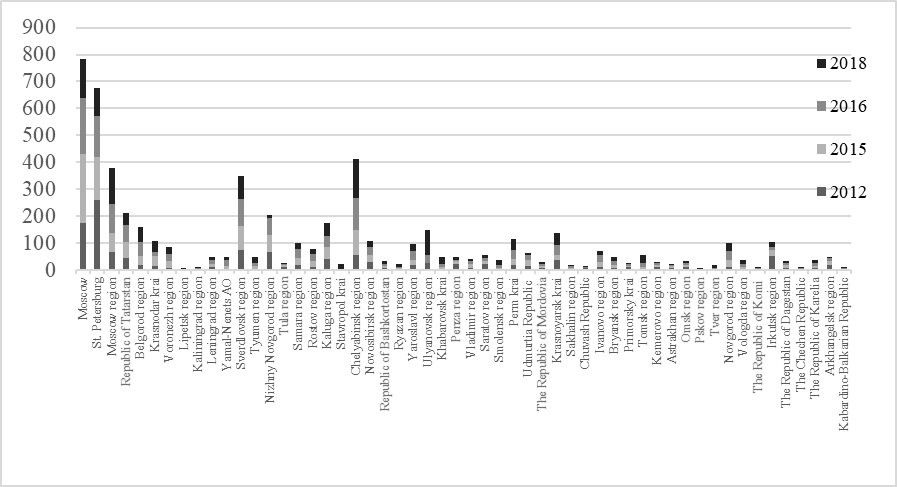
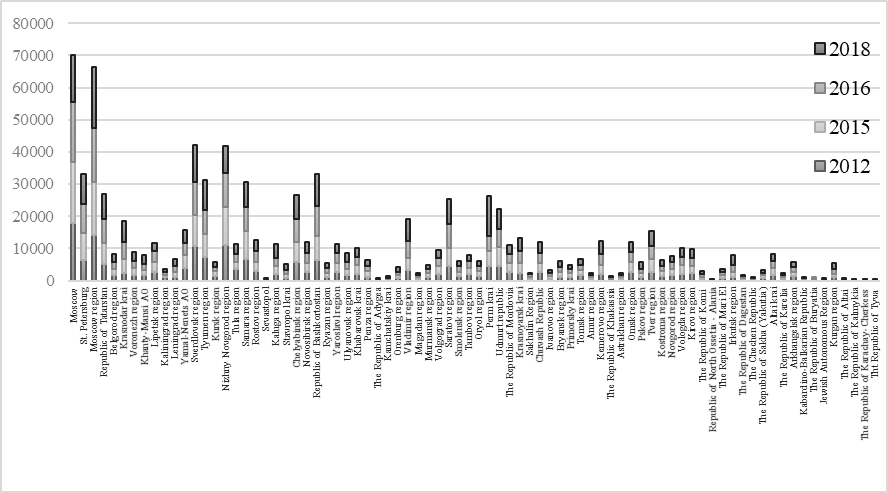
The leading place in both developed and used advanced manufacturing technologies is occupied by Moscow. Among the leaders in development of advanced manufacturing technologies are also St. Petersburg, Chelyabinsk Region, Moscow Region and Sverdlovsk Region. From 100 to 200 units of advanced manufacturing technologies were developed in 2015-2018 in the Republic of Tatarstan, Belgorod Region, Krasnodar Krai (Territory), Nizhny Novgorod, Samara, Novosibirsk, Yaroslavl, Novgorod, Irkutsk Regions, Perm and Krasnoyarsk Territories.
Significant volumes of use of advanced manufacturing technologies: 30,000 or more units, except Moscow, took place in Moscow, Sverdlovsk and Nizhny Novgorod Regions, the Republic of Bashkortostan, St. Petersburg, Tyumen and Samara Regions, the Republic of Tatarstan. In other territorial subjects of the Russian Federation the volume of used advanced manufacturing technologies is significantly less.
In order to conduct further research on the relationship “innovative development – quality of life”, we will use the data on the rating of the population quality of life in the regions, that is periodically formed by the RIA Rating agency according to the international methodology of the Economist Intelligence Unit (Quality of life in Russian regions, 2012; 2015; 2016; 2018). The rating is based on the analysis of more than 60 indicators combined in 10 groups characterizing the main aspects of quality of life. We use rating data for the same period as the data on the indicators “developed advanced manufacturing technologies” and “used advanced manufacturing technologies”.
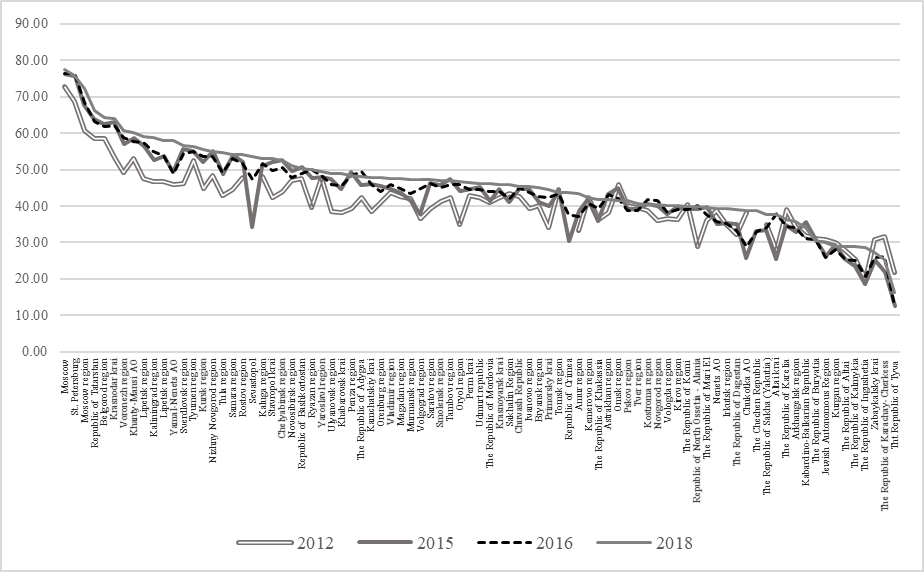
The population quality of life in territorial subjects of the Russian Federation in the period under review is growing, but the dynamics differ significantly in the regional context. Along with the regions of the Russian Federation demonstrating a steady increase in indicators, there are regions in which the quality of life in the indicated time interval does not improve and even falls (Figure
In 2018, the country's overall quality of life indicator ranged from 16.2 (the Republic of Tyva) to 77.4 (Moscow) on a 100-point scale. The data on the quality of life indicator averaged over the period are presented in Figure
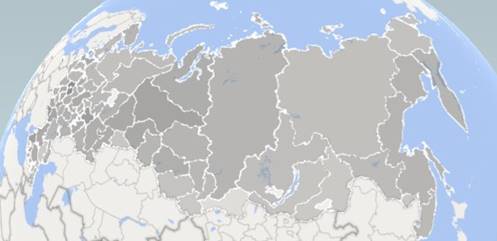
The map clearly illustrates the territorial heterogeneity of the quality of life of Russian population. In the context of the relationship analysis “innovative development – quality of life”, the identified heterogeneity is also valid in relation to the indicators of innovative activity that we have chosen in the territorial subjects of the Russian Federation. To verify the appropriateness of applying for analysis the relationship between the quality of life and the level of innovative development, the available statistical indicators “developed AMT” and “used AMT” will be used, we will use the methods of correlation and regression analysis. Intermediate results are shown in Figures
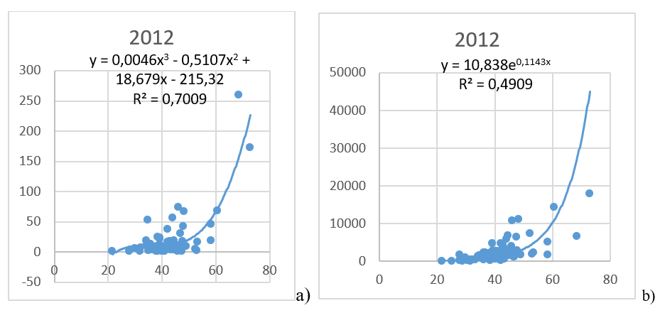
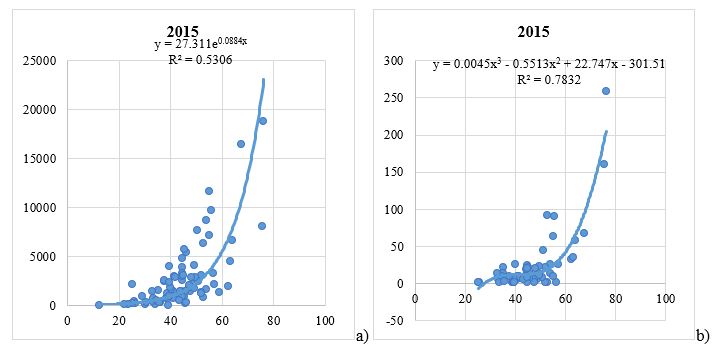
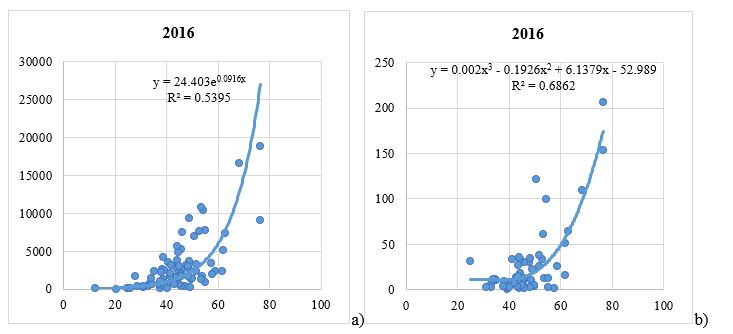
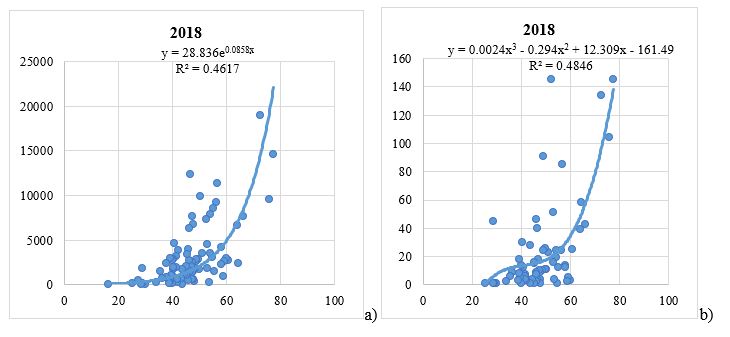
The presented results indicate that the dependence of selected indicators to characterize innovative activity: “developed advanced manufacturing technologies” and “used advanced manufacturing technologies” and the quality of life indicator is weak. This is confirmed by the obtained values of the approximation value, which for the period under consideration are in the range from 0.46 to 0.78, while smoothing can be considered reliable when the value of this indicator is 0.85 or higher (Getmanova et al., 2020).
In our opinion, in the future when analyzing the quality of life, it is necessary to take into account such an indicator as the proportion of innovative goods, works, services in the total volume of shipped goods, works, services (in the region). The methodology for such a calculation exists and is determined by the order of Rosstat of December 15, 2017 No. 832 (Official website of the Federal State Statistics Service, 2020).
Conclusion
Russian regions are highly differentiated in terms of quality of life and in terms of their contribution to the country's innovative development. The analysis revealed a steady dependence – the regions with high indicators of quality of life are also donors of innovative development. Low indicators of innovative activity make us study not only the investment climate, but also the social conditions that create the conditions for innovative entrepreneurship (Ahlstrom et al., 2020; Farquhar, 2019; Feenstra & Romalis, 2014; Okrepilov et al., 2018).
The concept of a quality economics allows us for many years to find ways to improve product quality, process quality, quality of activities organization and quality of life. Having a huge amount of research methods and tools concentrated in metrology, standardization and quality management, the quality economics allows us to take into account the innovative development factors of the regions at the highest, resulting level of quality – the quality of life.
The proposed approach, based on strengthening the methods of quality economics by the methods of correlation and regression analysis, opens new opportunities in the field of building a model of quality of life management and can become an effective tool in the selection of strategic guidelines and methods of current management. By combining the requirements for the necessary quality of life and determining how to satisfy them, the model creates opportunities for the effectiveness growth of regional management.
References
- Ahlstrom, D., Arregle, J. L., Hitt, M. A., Qian, G., Ma, X., & Faems, D. (2020). Managing technological, sociopolitical, and institutional change in the new normal. https://doi.org/10.1111/joms.12569
- Farquhar, H., (2019). Positive Contributions of Scientific Management the Elimination of Some Losses Characteristic of Present-Day Manufacture The Quarterly Journal of Economics, 33(3), 466–503. https://doi.org/10.2307/1885947
- Feenstra, R. C., & Romalis, J. (2014). International Prices and Endogenous Quality The Quarterly Journal of Economics, 129(2), 477–527. https://doi.org/10.1093/qje/qju001
- Getmanova, G., Smirnova, M., & Yastrebov, A. (2020). Analysis of the relationship between quality of life and technological development of the regions of the Russian Federation. In Materials of the international forum Metrological support of innovative technologies (p. 165). St. Petersburg.
- Houneida, B. Br., & Slim H. (2018). The Effects of Human Capital on the Total Quality Management: High Technology Sectors. Journal of Management Research, 10(3), 1-13. https://doi.org/10.5296/jmr.v10i3.13103
- Official website of the Federal State Statistics Service (2020). http://www.gks.ru/wps/wcm/connect/rosstat_main/rosstat/ru/statistics/
- Okrepilov, V., & Gagulina, N. (2019) Development of an assessment of the quality of life of the region’s population Journal of Economic Theory, 16(3), 318-330.
- Okrepilov, V., Kuzmina, S., & Kuznetsov, S. (2018). Tools of Quality economics: sustainable development of a 'smart city' under conditions of digital transformations of the economy. International Scientific Conference 'Digital Transformation on Manufacturing, Infrastructure and Service (DTMIS-2018). (pp. 21-22). Publishing house of Peter the Great University.
- Quality of life in Russian regions (2015). RIA Rating Agency. http://riarating.ru/infografika/20160225
- Quality of life in Russian regions (2016). RIA Rating Agency. http://www.riarating.ru/infografika/20170220
- Quality of life in Russian regions (2018). RIA Rating Agency. http://www.riarating.ru/infografika/20190219
- Quality of life in Russian regions (2012). Results and calculation methodology. RIA Rating Agency. http://vid1.rian.ru/ig/ratings/life_2012.pdf
- Shilov, A. (2011). Innovative Economic. Science, Government, Business, 1, 128.
Copyright information

This work is licensed under a Creative Commons Attribution-NonCommercial-NoDerivatives 4.0 International License.
About this article
Publication Date
21 October 2020
Article Doi
eBook ISBN
978-1-80296-089-1
Publisher
European Publisher
Volume
90
Print ISBN (optional)
-
Edition Number
1st Edition
Pages
1-1677
Subjects
Economics, social trends, sustainability, modern society, behavioural sciences, education
Cite this article as:
Okrepilov, V., Gagulina, N., & Getmanova, G. (2020). Factors Of Innovative Development Of Regions In The Concept Of Quality Economics. In I. V. Kovalev, A. A. Voroshilova, G. Herwig, U. Umbetov, A. S. Budagov, & Y. Y. Bocharova (Eds.), Economic and Social Trends for Sustainability of Modern Society (ICEST 2020), vol 90. European Proceedings of Social and Behavioural Sciences (pp. 409-418). European Publisher. https://doi.org/10.15405/epsbs.2020.10.03.46

